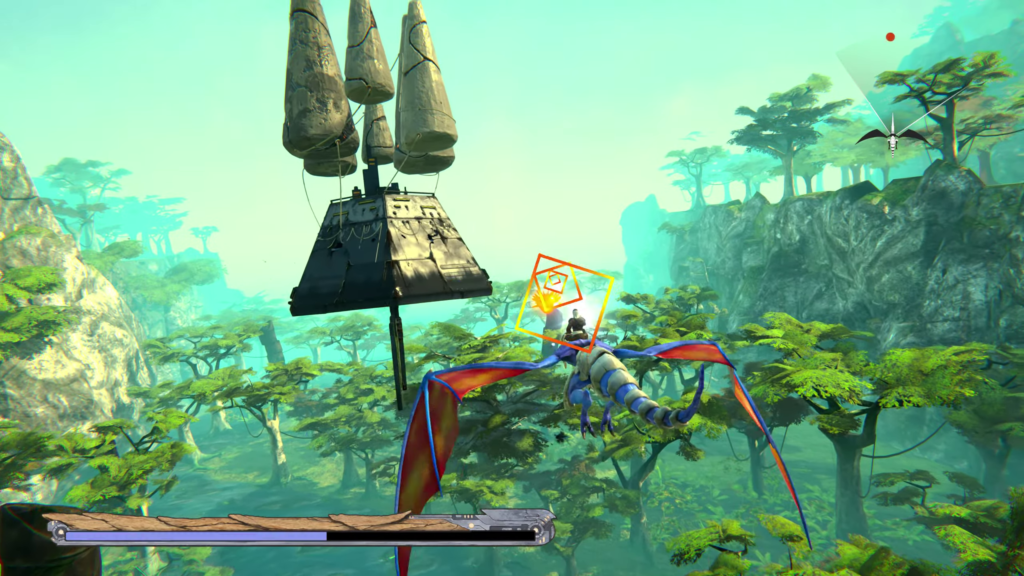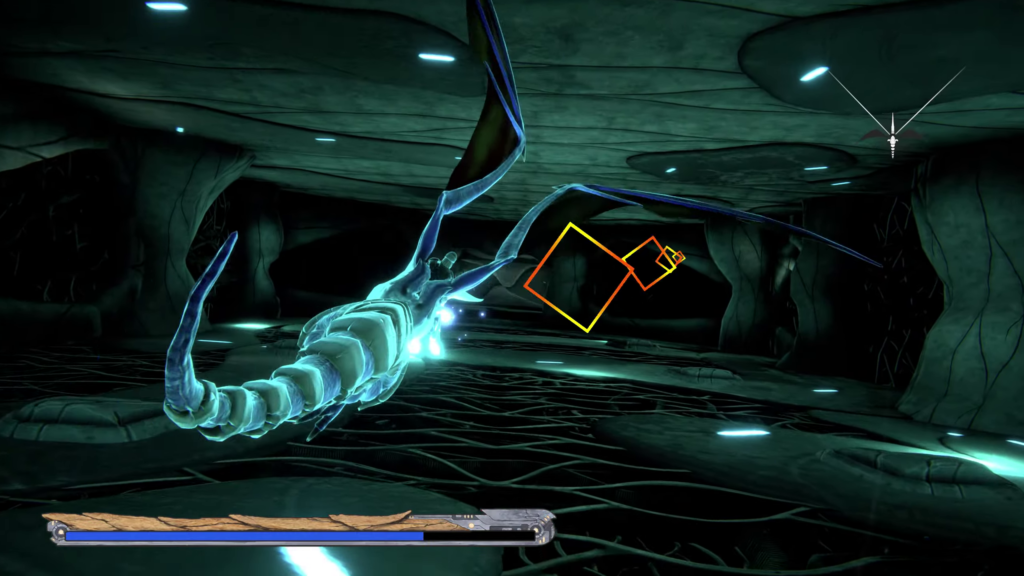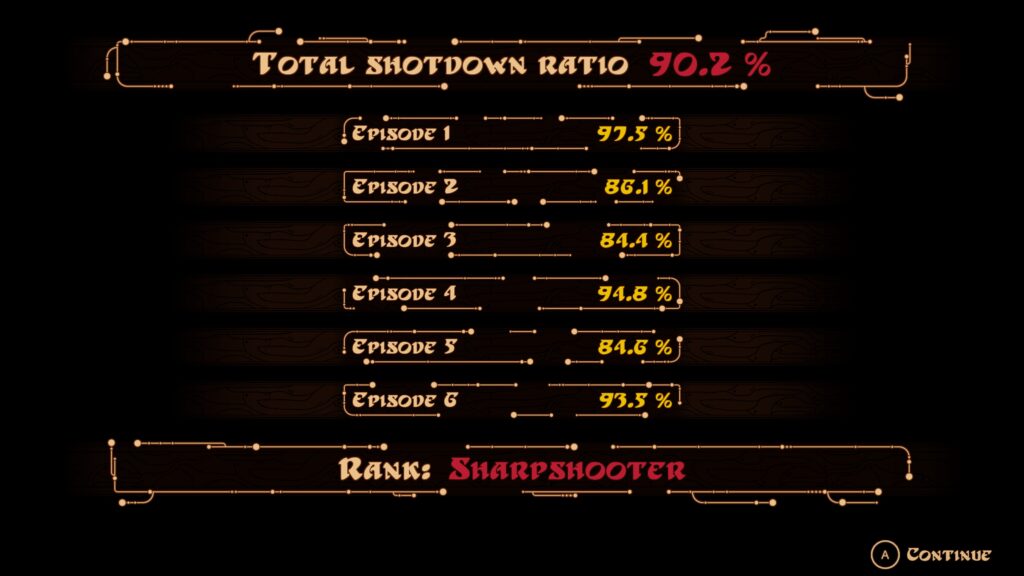As somebody who didn’t own a Saturn during its heyday, Panzer Dragoon didn’t mean much to me except as a four-figure RPG and a flashy shooter that showed up in early Xbox commercials. The original game finally pinged on my radar when I watched a video by Digital Foundry exploring the origins of the franchise and the best way to play the games today. I had just purchased a Saturn myself and was looking for good reasons to turn the device on that weren’t Capcom fighters.
Panzer Dragoon is a game that’s rarely made these days. Contrasting with run-and-gun shooters of the modern era, your player is piloting a flying dragon that is largely on autopilot, save for the ability to nudge him slightly to dodge an obstacle. As you fly through a variety of environments, your tasked with eliminating as much enemy resistance as you can, usually leading up to a boss fight against a massive war machine or monster.
Panzer Dragoon’s aiming mechanic is arguably its best known feature. You can quickly tap the attack button for standard rapid fire, or you could hold the button down and sweep your aiming reticle over a group of enemies to lock onto all of them at once. Letting go of the button and vaporizing up to eight enemies at once is extremely satisfying, as is firing multiple precision blasts onto a boss’ weak point. It’s not entirely new to me – Rez does something similar, and even the GBA version of Teenage Mutant Ninja Turtles uses it during one of its railed shooter levels – but it’s still a fun way to play, even if I prefer a mouse for this sort of precision aiming.
This is all hearsay, of course, as I still haven’t explored the Saturn version of Panzer Dragoon or any of its ports. That changed in 2020 – a year in a gaming generation already crowded with remakes and remasters – when the Sega classic launched on the Switch with updated graphics, modernized cutscenes, a rearranged soundtrack, and a number of quality of life improvements. As somebody who had never played the original game, the remake looked like a dramatic facelift compared to the Saturn’s crunchy 32-bit 3D graphics.

Panzer Dragoon’s environments improved greatly with their graphical facelift. The famous first level, in which the dragon flies across the surface of the water, has gorgeous water effects and bright colors. The fifth level takes the player into a forest canopy with beautiful mist effects. Any setting that speckles the landscape with flora or structures tends to look fantastic, though some of the less-populated levels – like the desert – sometimes look bland or unfinished.
I’m also a huge fan of the rearranged soundtrack. The melodies for each level are rich and full of instruments, and the tunes that accompany each boss fight are appropriately breathless and riveting. At the same time, in a good way, the score still has an appreciated “old school” element that clearly identifies them as Japanese video game music from the mid-nineties. It’s the element of the game that benefited most from the remake process.
If you haven’t figured out yet, there are a few “buts” coming.
While the graphical clarity brought new life to the game’s scenarios, they also better illustrate the game’s bizarre art style and character designs. The player’s dragon is fluid and well-animated, but most of the other enemies and enemy structures in the game didn’t receive the same care. Especially with crawling monsters, movement speed and model animations don’t seem in sync, with many monsters moving faster than their limbs would suggest, like everything is skating on ice. Many elements of the game are also covers in a bone-like armor, which likely blended better a 32-bit console but looks like a blobby mess with modern graphics.

If the game was more like other railed shooters and filled the screen with fast-moving, focus-blurring enemies, these individual design choices would likely fade into the action without much fuss. As is, however, Panzer Dragoon feels like a slow game. The frame rate is fluid, and the animations are smooth, but the dragon itself flies at a sluggish pace, and enemies are rationed so you never feel truly threatened until you reach a boss. There are exceptions – the final level approaches a more genre-appropriate level of chaos, and the fourth level has the dragon flying swiftly and satisfyingly through a narrow tunnel filled with obstacles – but the game is decidedly less metal than “giant dragon blows up ancient enemies with laser eyes” synopsis would suggest.
Panzer Dragoon is also quite short. The publisher realized this and never tried to get more than $24.99 for the game, but six levels that barely stretch five minutes a piece at a lukewarm difficulty will be completed very quickly. This is the perfect sort of game for Xbox Game Pass or Stadia Pro as its hard to justify it as a standalone investment with so little content and so few unlockables to be had. Even the achievements are sandbagged a bit.
This most recent playthrough was my second time playing through the game on Stadia. During my first run, I found the game to be a beautiful snack with satisfying shooting mechanics. My opinion (nor my performance) didn’t change much the second time around, though I did find myself wishing for a mouse to further optimize my performance with the aiming reticle, and I was better prepared for the game’s aforementioned moments of heightened intensity.
If the game succeeded at anything, it’s that it made me want to go back and explore the original games and see how they fared on their native platforms. Don’t be surprised if I dust off the Saturn – which went woefully ignored last year – to ride the dragon in her original 32-bit glory.





